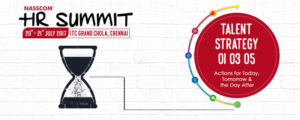I thought of sharing some of my consolidated notes from this year’s Nasscom HR Summit 2017 in Chennai (July 20-21, 2017).
“HR is not an agenda item. It is the agenda”. – Jeffrey Immelt, GE
LEADERSHIP
- Next big leadership focus may be on leading differences and harnessing diversity.
- Differentiated organization needs for “future fit”: 1. Adaptive Intelligence. 2. Culture fit – DNA (Very difficult to replicate organizational culture) and Curiosity Conversations (Really important to ask multiple “Why” questions and encourage them in your culture).
- Leaders are brokers of hope. There is a thin line between hope and despair.
FUTURE DIGITAL WORLD
- A key challenge today while thinking about change and future: In 2008, 73% of business ideas were Continuations. 12% were Novelties. Now, 71% of ideas are Novelites and 14% are Continuations.
- A useful idea about the future needs to be ridiculous. What ridiculous idea are you entertaining about the future in your organization?
- We will see more of Digitally Autonomous Organizations (DAO) – that involve very few to no management layers. That could be termed as technology enabled holocracy.
- In a future digital world, there is a need to approach metrics differently. eg. Mahindra is moving from measuring number of cars sold to number of miles driven. There will also be a need to look at different business models that may challenge existing revenue and business models. Mahindra launched a separate tractor company called Trringo, that is similar to Uber for tractors (while maintaining their traditional tractor business).
- The role of HR in a digital organization has to be more customer facing and focussed. e.g., AirBnB community interaction sessions are facilitated by HR.
WORK
- We cannot ignore the social elements of disruption in our work environment. All sectors, especially government will have to rethink and implement a strong support umbrella for those losing jobs and effective re-skilling.
- Approximately, 30% of India labour is on temporary or contract labor. Most of it seem to be not out of choice. A key question is how this will evolve in coming years, related impact on society and how our systems and support will need to evolve accordingly. Organizations will need to figure out more effective ways to manage a flexible talent pool. Government will again need to play a key role in thinking and establishing related public policies when the dynamics of employment relationships change.
- The delivery of work in future will change significantly. Open business models are redefining value and leads to the emergence of new roles. Robotics and analytics will drive higher productivity. As a result, the employer employee relationship will also continue to evolve.
LEARNING
- Continuous education aspect that involves learning beyond formal education throughout one’s career is growing in importance. There seems to be at least three key cycles of learning today in our lives – formal education years, the first few years at work and around mid career.
- Companies need multiple learning interventions and re-skilling initiatives for the future. Some companies have trained employees on agile ways of working.
- To enable behavioral change, it helps to do multiple small pilot projects.
- Effective learning should be accessible Anytime, Anyway, Anywhere.
HR TECHNOLOGY
- The focus of HR systems and tools is moving to “Interaction” from “Information”.
- Majority of employee interaction on HR systems are moving to chat and voice. There will be no need for an employee to see the HR Management System.
- Internal employee experiences need to mimic external customer experiences.
- For technology to be effective, it must support story telling and connection.
- YES Bank uses Facebook At Work for communication and collaboration. It seems to be working well for them.
HR PRACTICES
- Citi sends all their graduates to NGOs and villages for one week, to get first hand experiences. HR folks spent 9 months taking on line responsibilities.
- HR needs to think like the Marketing function and all solutions have to be simplified.
- Career relationship managers or mentors will play an increasingly important role in organizations in future.
- Google seems to have a Googler To Googler Guru Program Tool or Platform that connects experts in the organization to other employees, involving mentoring support.
PERFORMANCE MANAGEMENT IN GE
Many folks still continue to refer to the GE bell curve distribution approach in performance management. GE no longer follows that approach. They have completely revamped their famous performance management system and removed the bell curve distribution approach. Some key elements of their new system include:
- No annual goals, only priorities that are updated through the year.
- No ratings. Focus is on “real-time” inputs for development and improvement. Feedback has been renamed to ‘Insights’ and anyone in the organization can share with the individual through a smart device application (This is based on neuroscience studies that the term feedback results in defensiveness that also blocks proper processing of feedback).
- Related areas that still seem to require continued focus and work in this revamp are improving clarity for employees and communication around rewards distribution.
Hope these notes have provided at least couple of useful ideas.
Best wishes to you for the week ahead.





Recent Comments